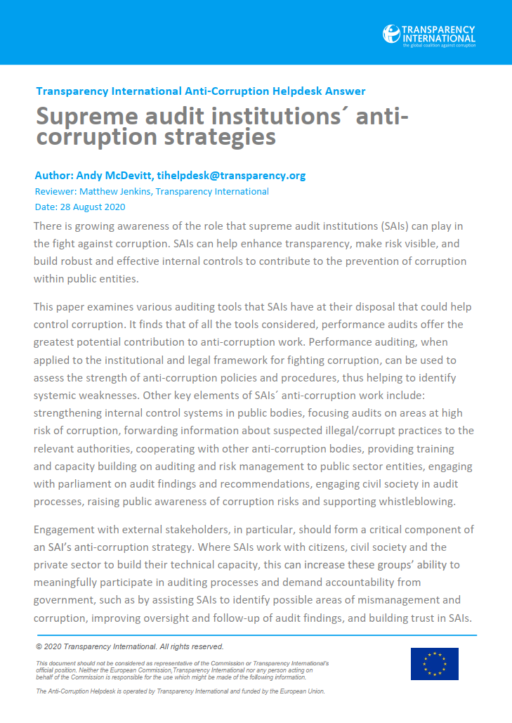
This Anti-Corruption Helpdesk brief was produced in response to a query from one of Transparency International’s national chapters. The Anti-Corruption Helpdesk is operated by Transparency International and funded by the European Union.
Query
Please provide an overview of strategies adopted by supreme audit institutions to support the fight against corruption. What elements do such strategies contain? What tools and mechanisms have been used? What lessons can be learned about designing such strategies in a participatory way?
Summary
There is growing awareness of the role that supreme audit institutions (SAIs) can play in the fight against corruption. SAIs can help enhance transparency, make risk visible, and build robust and effective internal controls to contribute to the prevention of corruption within public entities.
This paper examines various auditing tools that SAIs have at their disposal that could help control corruption. It finds that of all the tools considered, performance audits offer the greatest potential contribution to anti-corruption work. Performance auditing, when applied to the institutional and legal framework for fighting corruption, can be used to assess the strength of anti-corruption policies and procedures, thus helping to identify systemic weaknesses. Other key elements of SAIs´ anti-corruption work include: strengthening internal control systems in public bodies, focusing audits on areas at high risk of corruption, forwarding information about suspected illegal/corrupt practices to the relevant authorities, cooperating with other anti-corruption bodies, providing training and capacity building on auditing and risk management to public sector entities, engaging with parliament on audit findings and recommendations, engaging civil society in audit processes, raising public awareness of corruption risks and supporting whistleblowing.
Engagement with external stakeholders, in particular, should form a critical component of an SAI’s anti-corruption strategy. Where SAIs work with citizens, civil society and the private sector to build their technical capacity, this can increase these groups’ ability to meaningfully participate in auditing processes and demand accountability from government, such as by assisting SAIs to identify possible areas of mismanagement and corruption, improving oversight and follow-up of audit findings, and building trust in SAIs.
Main points
- Although supreme audit institutions (SAIs) are not considered anti-corruption bodies per se, in practice they perform a number of key functions that can contribute to efforts to curb corruption.
- When suitably adapted, performance auditing can be particularly useful for identifying systemic weaknesses in a country´s anti-corruption system.
- Engagement with external stakeholders is critical to strengthen SAIs’ effectiveness in holding governments to account. For example, citizens and CSOs can provide information on areas of possible corruption for audits and help monitor the executive´s response to audit recommendations.
Contents
- The role of SAIs in controlling corruption
- Key elements of SAIs´ anti-corruption work
- Tools and mechanisms to support anti-corruption efforts
- Stakeholder engagement and participation in SAIs´ anti-corruption work
- References
Authors
Andy McDevitt, [email protected]
Reviewer:
Matthew Jenkins, Transparency International
Date
31/08/2020
Tags
 Download PDF
Download PDF
